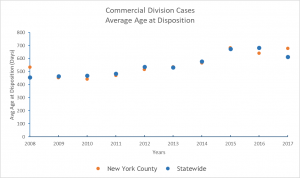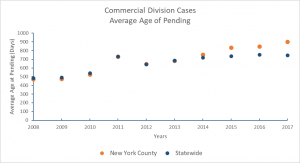Commercial Division Blog
Posted: April 6, 2018 / Categories Commercial, Commercial Division Justices
Guest Post: Data Show Cases in the Commercial Division Are Taking Longer to Resolve
This is the second in a series of posts presenting a quantitative description of the Commercial Division, with a special focus on New York County, by guest blogger Isaac B. Zaur.
The average case disposed of in New York Country’s Commercial Division in 2017 had been active for a little under two years (678 days, to be exact). That reflects an increase of more than 25% from 2008, the earliest year for which comparable data was made available. Statewide figures show a similar pattern, with the average age at disposition rising 35% from 455 days in 2008 to 613 days last year.
As shown in this graph, the increase has been relatively consistent over that period:

Of course, average age at disposition is only one way of looking at the issue—and may be of limited utility in counseling clients. We can say, very roughly, that the “average” case takes a little under two years to resolve. But, almost certainly, case lifespans are not distributed in a normal bell curve centered at that average figure. Rather, common-sense and litigation experience tell us that, if we could plot the lifespans of these cases, we would see a multi-modal distribution with peaks corresponding to resolutions at various procedural stages. The data currently available does not allow us to see those individual peaks. Hence, it is impossible to know, from this set of data alone, how long it takes, even on average, to dispose of a case by motion to dismiss, or through trial, or at the conclusion of fact discovery.
Another interesting feature of the data is the disconnect between the average age of cases disposed of in a given year and the average age of cases still pending at the end of that year. For example, the average case pending in New York County’s Commercial Division at the end of 2017 was 901 days old—compared to 678 days average age at disposition for cases resolved that year. For some, this may be counter-intuitive: for most (but not all) of the years we have data for, it appears that the average case pending in the Commercial Division is older than the average time it takes to dispose of any given case. There may be a number of explanations for this—one obvious one is that there exists a cluster (or clusters) of very long-lived cases, yet to be resolved, that are exaggerating the average age of pending cases.
The aging of the “inventory” of Commercial Division cases is actually fairly dramatic. In New York County, the average age of pending cases has nearly doubled since 2008, from 470 days to 901 in 2017. The statewide increase was also significant, as illustrated by the following graph:

It is not obvious, from this data, why cases are taking longer to resolve. Caseload volume alone does not appear to be driving the trend, as there were fewer active cases in the Commercial Division, statewide, in 2017 than in 2008. (There was an increase of about 10% in New York County—potentially significant but seemingly not nearly enough to account for the 27% increase in age at disposition or the 92% increase in age of pending cases.)
This trend—at least on the surface—should be frustrating to litigants, practitioners, and perhaps most of all to the courts themselves. This is especially true in light of the substantial effort invested in rule-based reforms to practices in the Commercial Division in recent years. As readers of this blog are well aware, the Unified Court System has adopted a number of new rules following the 2012 report of the Chief Judge’s Task Force on Commercial Litigation on the 21st Century, many of which were intended to streamline and accelerate litigation in the Commercial Division. It would be gratifying to see a clear statistical impact from those rules. However, no such impact is discernible in these figures. Indeed, virtually the entire increase in time to disposition has come since 2013—when the first reforms inspired by the Chief Judge’s Task Force were implemented. To be sure, we can only guess at what these statistics would look like had the reforms not been implemented.
One important rule change that could account for some of this data is the increase in monetary thresholds for assignment to the Commercial Division. In 2014, the minimum amount in controversy for assignment of most types of cases to the Commercial Division increased. This presumably excluded some less-complex cases, which would be expected to both limit the total number of new cases and skew the balance of cases toward those with more thorny issues (or at least more incentive for vigorous litigation).
Perhaps relatedly, the Commercial Division has seen a significant increase in the number of motions filed, which may account at least in part for the increasing time from commencement to resolution. The impact of increasing motion practice will be the subject of an upcoming post.
It also seems likely that cases arising from failed residential mortgage-backed securities, clustered in New York County, are disproportionately impacting the average lifespan of both pending and resolved cases. It will be interesting to see how these figures trend as those cases gradually make their way out of the system.
In future posts, I intend to explore the available data in greater detail, in hopes of identifying strategies that may aid both litigants and the Unified Court System in achieving the goals of faster, cheaper, and better adjudication in the Commercial Division. My deep thanks go to the UCS staff who made this data (and these graphs) available, including Marina Swartz, Chip Mount, and Michael Hall, and to Chief Administrative Judge Lawrence K. Marks. Any errors of interpretation or analysis, of course, are my own.
Note: This guest post was authored by Isaac B. Zaur, a partner at Clarick Gueron Reisbaum LLP. Isaac would welcome any comments or feedback via e-mail at izaur@cgr-law.com.
